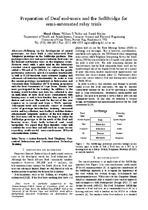| dc.contributor.author | Glaser, Meryl | |
| dc.contributor.author | Tucker, William David | |
| dc.contributor.author | Mashao, Daniel | |
| dc.date.accessioned | 2012-10-26T11:54:37Z | |
| dc.date.available | 2012-10-26T11:54:37Z | |
| dc.date.issued | 2004 | |
| dc.identifier.citation | Glaser, M., Tucker, W. D., & Mashao, D. (2004). Preparation of Deaf end-users and the softbridge for semi-automated relay trials. In D. Browne (ed.), Southern African Telecommunication Networks and Applications Conference (SATNAC), 2: 255–256, Stellenbosch, South Africa | en_US |
| dc.identifier.isbn | 0-620-32632-8 | |
| dc.identifier.uri | http://hdl.handle.net/10566/447 | |
| dc.description.abstract | Following on the development of several prototypes, we have built a semi-automated Deaf Telephony prototype on the SoftBridge platform. This prototype relays text and speech between Deaf users on the Internet and hearing users on the telephone system. Previous work with a pilot trial in the laboratory revealed several opportunities for enhancement. We added a Wizard of Oz (WoOz) to replace the poorly performing automatic speech recognition functionality as well as H.323 breakout, more extensive logging and advanced call initiation functionality. In order to trial the current prototype, we initiated an Information and Communication Technology (ICT) training programme with the Deaf Community of Cape Town. Twenty Deaf users participated in the training. In addition to the training, much baseline user data was collected to give an indication of how Deaf users communicate with hearing users as well as how familiar they are with ICT devices and services. The work for the rest of this year requires us to recruit and train a WoOz operator. Subsequent trials will essentially consist of monthly cycles of prototype introduction, training, automated metric and log collection, user feedback and then feature enhancement. Linguistic analyses of the text output of the Deaf users will be analyzed. We hope to refine the SoftBridge prototype to fit the needs of the Deaf and hearing users, from both technical and social viewpoints. We expect that these iterative cycles will continue for some time and will teach us many lessons regarding multi-modal semi-synchronous IP-based communications systems. | en_US |
| dc.description.sponsorship | Telkom, Siemens, THRIP, SANPAD | en_US |
| dc.language.iso | en | en_US |
| dc.publisher | Telkom | en_US |
| dc.rights | Copyright Telkom. This file may be freely used for educational purposes, as long as it is not altered in any way. Acknowledgement of the authors and the source is required | |
| dc.subject | Action research | en_US |
| dc.subject | Deaf telephony | en_US |
| dc.subject | User-centred design | en_US |
| dc.subject | Information and communication technology (ICT) | en_US |
| dc.subject | Training | en_US |
| dc.title | Preparation of Deaf end-users and the softbridge for semi-automated relay trials | en_US |
| dc.type | Conference Proceedings | en_US |
| dc.privacy.showsubmitter | FALSE | |
| dc.status.ispeerreviewed | TRUE | |

